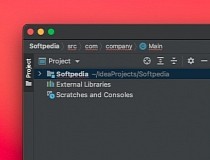

- #Android sdk for mac intellij mac how to#
- #Android sdk for mac intellij mac zip file#
- #Android sdk for mac intellij mac android#
- #Android sdk for mac intellij mac plus#
#Android sdk for mac intellij mac how to#
WebDriver doesn’t know how to do anything other than talk to the browser driver. Important Note: You may need to restart your editor in order for changes to the PATH environment to take effect. You’ll need to add that location to your system’s PATH environment variable.
#Android sdk for mac intellij mac zip file#
Make sure to grab the driver that’s appropriate for the version of Windows you’re running (x32, 圆4).ĭownload the zip file and extract the driver to a location on your system. Firefox’s driver is part of Mozilla’s Gecko Driver releases. Proxies for all WebDriver-supported browsers are listed on the SeleniumHQ’s list of Third Party Drivers. This example uses Firefox, so you’ll need to grab the appropriate proxy. You’re done! Adding The Firefox Driver ProxyĪs noted in the WebDriver Overview in the first post of this series, you’ll need to have a proxy for your test to talk to the actual browser. Here’s what the dialog looks like when you’re done. Click the Dependencies tab on the right, then use the “+” icon and add in the directory you saved the Selenium files to-”libs” in this example. Use File => Project Structure to get the Project Structure dialog open, then select the Modules menu on the left. Depending on your architecture you may need to unzip the zip file. I generally include a “libs” folder in my projects for external libraries like this. Load Libraries Into IntelliJĭownload the Java WebDriver bindings and the standalone server (selenium-server-standalone-3.4.0.jar and selenium-java-3.4.0.zip, e.g.) and save them to a handy spot. This post uses a simple static library inclusion due to the wide variances in how teams organize Maven and Gradle. Most mature teams use a build and dependency management system like Maven or Gradle. There are many ways to include WebDriver in your IntelliJ projects. Give the project a good name and select a directory to store your project.Īt this point you’re at the IntelliJ project’s home. In the next screen leave the Create project from template checkbox cleared and click Next Creating The ProjectĪt startup IntelliJ will prompt you for basic actions-you can choose Create New Project right from the opening screen.įor this example choose the simple Java project with none of the additional library options selected and click Next. Starting IntelliJ the first time will prompt you for various defaults (locations, keyboard mappings, etc.).

Installing IntelliJ is a matter of following instructions for the version you’ve downloaded. This article will use the Community variant on Mac’s OSx. All variants are available for download from IntelliJ’s homepage. Both releases are available on the Mac, Linux, and Windows platforms.
#Android sdk for mac intellij mac android#
IntelliJ IDEA comes in two releases: Ultimate, a commercial product that supports a wide range of development scenarios, and Community, a free version for Java Virtual Machine and Android development. WebDriver’s Java Standalone Server library.A test framework (We’ll use JUnit there are many you can use)¥ WebDriver’s Java bindings.To create and run WebDriver tests in Java using IntelliJ you’ll need the following components: This article is one in a series showing how to get WebDriver working in various editors and language platforms.įor an overview of how WebDriver works, please see the section “WebDriver Overview” in the article “ Getting Started with Webdriver/Selenium for Java in Eclipse”.
#Android sdk for mac intellij mac plus#
In this article, we'll work on the OSx platform and show you how to get the various parts and pieces, plus write and run one simple test in Java. IntelliJ is a popular, widely used Java Integrated Development Environment (IDE) made by JetBrains.


 0 kommentar(er)
0 kommentar(er)
